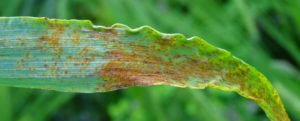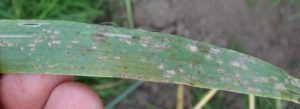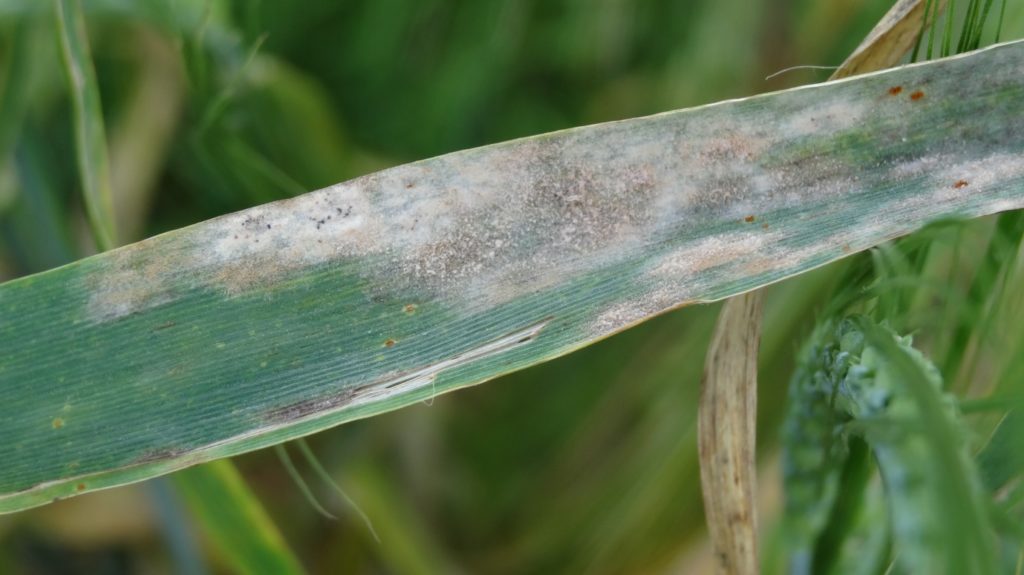Cold snap may arrest crop disease development
23 November 2018Crop brairds in Scottish winter cereals have benefited from the mild autumn and adequate moisture, which is in contrast to some regions in the south where crops have failed to establish well in dry conditions. But warm autumns also bring enhanced risk of early infestations with pests and diseases and a few are already making an appearance in winter barley crops, with brown rust popping out in a few Borders crops and mildew also being seen in crops over quite a wide geographic range.

Brown rust in barley is an indication of how mild the autumn has been so far. It will not enjoy the sudden plunge in temperature
Brown rust is hot weather disease so is a classic indicator of warm weather. It needs temperatures of well over 15oC and is a bigger deal in the south of England where they consistently get the warm temperatures that promote it. It doesn’t usually like our chillier climate, and although it isn’t common we do see brown rust quite frequently in SRUC barley trials – but it is rare to see it this early. It seldom amounts to anything but it is a measure of the mild autumn. Many winter barley varieties carry reasonable resistance – KWS Glacier is a 7 for example, but many, like SY Venture and Volume are rated 6 is which is OK but not brilliant.
Mildew is a fairly regular occurrence for us in warm autumns so less surprising to see in crops this season. In contrast to the spring barley crop where good mildew resistance is common, many winter barley varieties are intermediate and rated 5 (Volume) or 4 (KWS Glacier). Net blotch and ryhynchosporium, although not commonly reported this autumn, can also make an autumn appearance in early drilled crops in a warm season. Last autumn in 2017 we were lucky to see very little disease in autumn crops and the hard winter kept them clean so that there was little early disease pressure in the spring of 2018 and consequently less need for heavy first sprays at the start of stem extension (T1) or early clean up sprays before this at T0.

Mildew and brown rust (shown above) along with net blotch and Rhynchosporium are relatively common in barley crops going into the winter and crops should be monitored in the spring to see if early treatment is required
Management in the autumn is seldom cost effective although that’s a decision to be made on a case by case basis. The sudden plunge in temperature will help to check disease, as will the predictions of a hard winter. Crops should be walked regularly to keep an eye on disease development. Well established crops can stand a bit of leaf loss though so don’t be too concerned now and just keep it in mind when planning spring sprays, where you might need to make an early start in infected crops. SRUC trials with autumn sprays show that they are not often cost effective. Where they do show some yield advantage it is around a quarter to a third of a tonne but no greater than that achieved with T0 sprays in the spring. The advantage of waiting to spring is that you can judge the real need as the winter may do the clean up job for you.
It is self-evident that the weather is one of the most important drivers of disease risk but the sudden switch from warm to cold this week really illustrates how important it is not to lay plans based on average expectations, nor should spray plans be set in stone too early or be based on last season. If it stays cold this early disease shouldn’t be a worry.
Fiona Burnett, SRUC for the Farm Advisory Service
Sign up to the FAS newsletter
Receive updates on news, events and publications from Scotland’s Farm Advisory Service

